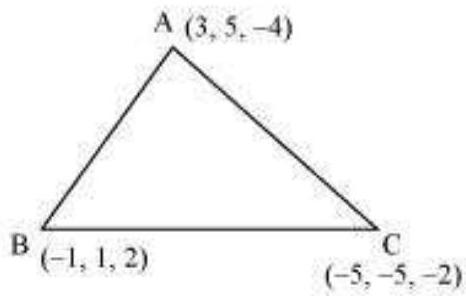Chapter 11 Three Dimensional Geometry EXERCISE 11.1
EXERCISE 11.1
1. If a line makes angles $90^{\circ}, 135^{\circ}, 45^{\circ}$ with the $x, y$ and $z$-axes respectively, find its direction cosines.
Show Answer
Solution
Let direction cosines of the line be $l, m$, and $n$.
$l=\cos 90^{\circ}=0$
$m=\cos 135^{\circ}=-\frac{1}{\sqrt{2}}$
$n=\cos 45^{\circ}=\frac{1}{\sqrt{2}}$
Therefore, the direction cosines of the line are $0,-\frac{1}{\sqrt{2}}$, and $\frac{1}{\sqrt{2}}$.
2. Find the direction cosines of a line which makes equal angles with the coordinate axes.
Show Answer
Solution
Let the direction cosines of the line make an angle $a$ with each of the coordinate axes.
$\therefore l=\cos a, m=\cos a, n=\cos a$
$ \begin{aligned} & l^{2}+m^{2}+n^{2}=1 \\ & \Rightarrow \cos ^{2} \alpha+\cos ^{2} \alpha+\cos ^{2} \alpha=1 \\ & \Rightarrow 3 \cos ^{2} \alpha=1 \\ & \Rightarrow \cos ^{2} \alpha=\frac{1}{3} \\ & \Rightarrow \cos \alpha= \pm \frac{1}{\sqrt{3}} \end{aligned} $
Thus, the direction cosines of the line, which is equally inclined to the coordinate axes,
are $\pm \frac{1}{\sqrt{3}}, \pm \frac{1}{\sqrt{3}}$, and $\pm \frac{1}{\sqrt{3}}$.
3. If a line has the direction ratios $-18,12,-4$, then what are its direction cosines?
Show Answer
Solution
If a line has direction ratios of $-18,12$, and -4 , then its direction cosines are
$\frac{-18}{\sqrt{(-18)^{2}+(12)^{2}+(-4)^{2}}}, \frac{12}{\sqrt{(-18)^{2}+(12)^{2}+(-4)^{2}}}, \frac{-4}{\sqrt{(-18)^{2}+(12)^{2}+(-4)^{2}}}$
i.e., $\frac{-18}{22}, \frac{12}{22}, \frac{-4}{22}$
$\frac{-9}{11}, \frac{6}{11}, \frac{-2}{11}$
Thus, the direction cosines are $-\frac{9}{11}, \frac{6}{11}$, and $\frac{-2}{11}$.
4. Show that the points $(2,3,4),(-1,-2,1),(5,8,7)$ are collinear.
Show Answer
Solution
The given points are $A(2,3,4), B(-1,-2,1)$, and $C(5,8,7)$.
It is known that the direction ratios of line joining the points, $(x_1, y_1, z_1)$ and $(x_2, y_2, z_2)$, are given by, $x_2-x_1, y_2-y_1$, and $z_2-z_1$.
The direction ratios of $A B$ are $(-1-2),(-2-3)$, and $(1-4)$ i.e., $-3,-5$, and -3 . The direction ratios of $BC$ are $(5-(-1)),(8-(-2))$, and $(7-1)$ i.e., 6,10 , and 6 . It can be seen that the direction ratios of $B C$ are -2 times that of $A B$ i.e., they are proportional.
Therefore, $A B$ is parallel to $B C$. Since point $B$ is common to both $A B$ and $B C$, points $A, B$, and $C$ are collinear.
5. Find the direction cosines of the sides of the triangle whose vertices are $(3,5,-4),(-1,1,2)$ and $(-5,-5,-2)$.
Show Answer
Solution
The vertices of $\triangle A B C$ are $A(3,5,-4), B(-1,1,2)$, and $C(-5,-5,-2)$.

The direction ratios of side $A B$ are $(-1-3),(1-5)$, and $(2-(-4))$ i.e., $-4,-4$, and 6 .
Then, $\sqrt{(-4)^{2}+(-4)^{2}+(6)^{2}}=\sqrt{16+16+36}$
$ \begin{aligned} & =\sqrt{68} \\ & =2 \sqrt{17} \end{aligned} $
Therefore, the direction cosines of $A B$ are
$ \begin{aligned} & \frac{-4}{\sqrt{(-4)^{2}+(-4)^{2}+(6)^{2}}}, \frac{-4}{\sqrt{(-4)^{2}+(-4)^{2}+(6)^{2}}}, \frac{6}{\sqrt{(-4)^{2}+(-4)^{2}+(6)^{2}}} \\ & \frac{-4}{2 \sqrt{17}},-\frac{4}{2 \sqrt{17}}, \frac{6}{2 \sqrt{17}} \\ & \frac{-2}{\sqrt{17}}, \frac{-2}{\sqrt{17}}, \frac{3}{\sqrt{17}} \end{aligned} $
The direction ratios of $BC$ are $(-5-(-1)),(-5-1)$, and $(-2-2)$ i.e., $-4,-6$, and -4 . Therefore, the direction cosines of $B C$ are
$ \begin{aligned} & \frac{-4}{\sqrt{(-4)^{2}+(-6)^{2}+(-4)^{2}}}, \frac{-6}{\sqrt{(-4)^{2}+(-6)^{2}+(-4)^{2}}}, \frac{-4}{\sqrt{(-4)^{2}+(-6)^{2}+(-4)^{2}}} \\ & \text{ i.e., } \frac{-4}{2 \sqrt{17}}, \frac{-6}{2 \sqrt{17}}, \frac{-4}{2 \sqrt{17}} \end{aligned} $
The direction ratios of CA are $(-5-3),(-5-5)$, and $(-2-(-4))$ i.e., $-8,-10$, and 2 . Therefore, the direction cosines of $A C$ are
$ \begin{aligned} & \frac{-8}{\sqrt{(-8)^{2}+(10)^{2}+(2)^{2}}}, \frac{-5}{\sqrt{(-8)^{2}+(10)^{2}+(2)^{2}}}, \frac{2}{\sqrt{(-8)^{2}+(10)^{2}+(2)^{2}}} \\ & \text{ i.e., } \frac{-8}{2 \sqrt{42}}, \frac{-10}{2 \sqrt{42}}, \frac{2}{2 \sqrt{42}} \end{aligned} $










